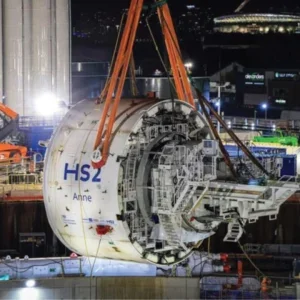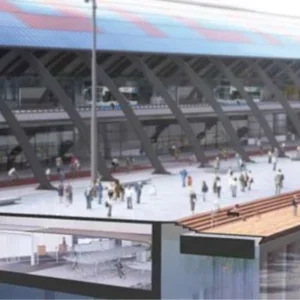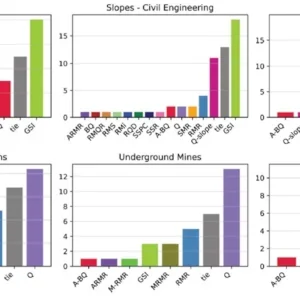The now finished TBM drives for a new tunnel to access Miami’s cruise liner and container port have been one of the world’s more complex tunnel jobs in recent times, geologically speaking. Complex ground works, including freezing, mixed-inplace wall panel construction and above all, extensive grouting have all been needed to get a big, 12.95m-diameter Herrenknecht EPBM through the ground.
Two drives of 4,200ft (1,280m) have been required for the new road link, the second finishing in May last year. Fitting out has been under way since, and the completed project opens later this summer.
Without Equal
An extraordinary limestone rock formation layer in the area causes the main complexity in the job. Like many limestones in the world, this is karstic with the kind of water-eroded fissures and voids that have created significant problems for tunnels like the SMART tunnel project in Malaysia’s Kuala Lumpur. But the Florida rock is even more difficult because it is more porous than usual, to such an extent that large diameter tunnelling has previously been considered impossible in much of the state of Florida.
The challenging nature of the rock is caused by its origin in undersea coral reefs. The ancient skeletal remains, compacted as rock, leave it with the texture and structure of a solid sponge, says Laurent Lefebvre a senior vice-president of Nicholson Construction, one of the US’ biggest grouting and groundworks contractors. Nicholson is a subsidiary of the major European groundworks specialist firm Soletanche Bachy.
The company carried out an approximately USD 40M subcontract to grout the rock on the Miami port tunnel alignment for main contractor Bouygues Civil Works Florida, which is doing the overall USD 640M construction work. Bouygues itself is also a subsidiary of a European firm, the French Bouygues Travaux Publiques.
One of eight different ground layers, the corraline limestone is found about 42m deep, which coincides with much of the alignment of the twin bores. Getting through it would be problematic, Bouygues decided, for several reasons. Firstly it is low in fines making standard EPB operation difficult because a pressure resisting plug would not form easily in the screw conveyor. Secondly the open structure makes the water filled rock potentially unstable.
"That became more apparent after an intensive programme of ground investigation carried out by the contractor," says Lefebvre. According to information from Bouygues’ geotechnical director Roger Storry, this lasted for nearly two years. Drill samples were taken every 10m and there were additional tests done using ultrasound, cone penetrations, permeability testing and camera log surveys. Samples were sent to Bouygues’ European headquarters for analysis. The contractor went further, sinking five shafts at the tunnel low points, each 2.5m in diameter.
With increased understanding of the ground, Bouygues’ solution, discussed with manufacturer Herrenknecht, was a modification to the 12.8m-diameter EPBM. It would be provided with a pressurised water circuit from the end of the screw conveyor, allowing the machine to operate somewhat like a slurry machine, with water pressure supporting the face and water transport for the spoil.
But the contractor also decided the corraline ground layer would need extensive grout treatment along much of the alignment and part of its preparation was to devise and test a system to do that. Lefebvre says Nicholson was one of several grouting companies called in for discussions and estimates by the contractor as it devised a grout that was sufficiently viscous or thixotropic to fill the "sponge structure of the rock" but without flowing too far from the grouting points.
The challenge was to fill the rock along the alignment but to avoid grout going too far, for both cost and environmental reasons. "You don’t want to fill the voids all the way to Miami downtown," says Lefebvre, "which would be expensive."
The work also had to avoid losses of bentonite to seabed or land to prevent any pollution. This was for obvious normal anti-pollution reasons as well as complying with additional special restrictions for the shoreline in the area, which is ecologically sensitive with subtropical animal and plant species like mangrove trees.
The viscous grout design used a mix of bentonite, sand and cement as well as additives and this was combined with a tight pattern of drill holes to achieve the just coverage required.
Pathfinding
"And even then you are talking about a lot of grout, filling some 30 per cent of the ground volume along the tunnel line," says Lefebvre. "It is more a filling than a grouting operation."
Along with finding a restricted flow grout, Bouygues also wanted to have the grout installed in stages through the thickness of the ground layer, using a so-called ‘downstage’ method. Upstage is more usual, where the ground layer is drilled to the bottom of the layer and then grouted as the drill string is withdrawn, in this case covering a 15m thickness.
But installing in a single pass is potentially more hazardous if there should be a leakage because, put simply, there is more unset grout to escape. Downstage does the work in smaller passes, drilling a short length, in this case just over 3m, and withdrawing and grouting, then re-drilling through this first layer to do the one below, and so forth until the full depth is done in about four sections.
"Normally that is time consuming because you have to remove the drill head and then grout and then re-install," says Lefebvre. "So we came up with a one-pass method that uses a two-way valve system at the surface – it has been patented – and could drill and grout and then re-drill without withdrawing the drills.
"Without that method we could not have dealt with a very demanding schedule." It helped the company when the time came to propose a bid to Bouygues.
Nicholson won the bid for the work in July 2011 at which stage Lefebvre was joined by project manager Luca Barison from the company’s special projects group based in Denver. New challenges now awaited, not least a limited 10-month period to do the work in restricted conditions.
The tunnel line crosses the main channel used by the cruise ships passing into Miami’s harbour area, which include some of the biggest of such vessels in the world. That meant about 80 per cent of the work had to be done over water, from spud barges, using one barge for the drill rig itself and one for its grouting pumps and grout reservoirs. The drills are quite large.
"When we thought about how to do the single pass system 40m down we initially were not sure how to tackle it," says Lefebvre. "But eventually we elected to use a drill guide system with a long lead 40m high suspended from a conventional American crawler crane." The leads were designed by a Nicholson sister company based in Canada.
"But to meet a quite demanding schedule we needed to have more than one drill at work," says Barison. "In fact at the peak point we had four."
That meant some eight barges arranged out into the channel forming a ‘bridge’ almost between one side and the other. The barges were linked together with walkways and also to shore with a bridge connection.
That sounds simple enough and Barison says that obtaining barges for hire was not difficult; Miami is near enough to the Gulf of Mexico offshore oil area to make such equipment readily available. But the arrangement had to be easily set up and dismantled because work could only be done within limited time windows to fit in with the harbour schedules; for the harbour authority priority goes at all times to the big cruise ships, which leave every few days. For these to pass the channel had to be clear. Clearing the passage took some hours as did setting up again. Nicholson had two tug boats permanently on hire for this work. Once operations were underway there had to be 24- hour working to make maximum use of time in windows which were sometimes just two or three days.
Even when the barges were in position, logistical issues were important, most of all supplying the grout mix and in the large quantities required. Nicholson explored the Miami area for ready mixed suppliers but none of them could handle the specialist mix needed and certainly not in large volumes.
"We needed our own batching plant," says Barison. Fortunately the worksite for the main contractor was big enough to accommodate a grout plant on the Watson Island side. This was connected to shore via a causeway link along which trucks could pass.
Transporting the mix to the barges was done with trucks; feeding concrete pumps at the shoreline connected to a pipeline though the barge connection bridge. These filled agitator tanks on the supply barges where the mix could be kept relatively fluid while it waited to go down to the limestone layer. Some 60-70m3 had to be pumped each hour. Each of the drill and grout reservoir pairs had its own pumpline.
"We thought about boats but it would have been too difficult," says Barison. An advantage of the bridge was that it allowed the first 20m of shoreline to remain untouched, an environmental constraint in the contract conditions. For the drilling operations themselves there were technical and environmental constraints. First was to ensure that the grout did not spill or enter the water.
"The drilling was all done inside an outer 300mm diameter casing, which was installed first and keyed into the seabed," says Barison, "so that any grout coming back up the drill hole would rise all the way to the barge."
To contain it there, the barges were all fitted with 150mm ‘lips’ around the sides that also served to hold in any spillage. "We also had divers on standby all the time in case there should be any issues," adds Barison.
The drilling itself was monitored in real time firstly using a Lutz system for the drill parameters such as rotation, pull down forces, water pressures and flows and then a software system, Grout IT, from Soletanche for the grouting work.
"This was connected to the office onshore and allowed us to monitor and record all the crucial parameters for the grouting, to assess how it was completing," he says.
The drilling itself was primarily on a 5m grid along the line of the tunnels, beginning with the eastbound drive from Watson Island across the to the other side. Grouting had to be done a month before the TBM reached any particular position.
"It was a bit tight at the beginning as we spent a while sorting out the methods and did not begin drilling until November," recalls Lefebvre.
"So that was a little tense but once we got going things were more relaxed," says Lefebvre. The grout progress went well and was well in advance of the TBM, eventually even finishing a little ahead of the schedule.
"We also some landside drilling to do," adds Barison, "including drilling at an oblique angle for the shoreline areas which were out of bounds for ecological reasons"
Picking up the tab
Port of Miami access tunnel is a twin bore connection into the commercial harbour area to the north of the famous resort and beach city areas.
When opened this year it will provide a direct route into the complex for up to 1,600 trucks daily from the interstate highways I395 and I95; currently they have to pass through the city causing congestion.
It is being built under a design-build-finance-operateand- maintain concession by a consortium, The Miami Access Tunnel Concessionaire (MAT). MAT is part of a public private partnership with the City of Miami, Miami-Dade County and the Florida Department of Transportation. Contractor Bouygues, which is carrying out the work, has a share in the group.
Under the concession agreement, FDOT will make milestone payments during the construction period, upon the achievement of contractual milestones. Once construction is completed, the concessionaire will receive payments contingent upon service quality. The tunnel will be returned to FDOT at the end of the contract in October 2044.
The main part of the work is twin drives of just over 1,200m, which were carried out by a single Herrenknecht TBM passing first eastwards, and then returning after a turning operation on the Dodge Island side of the channel. Watson and Dodge Islands are artificial islands created to form the port.
Miami is anticipating significant growth in the expanding cruise trade, and also in container freight, particularly after the project’s completion.






